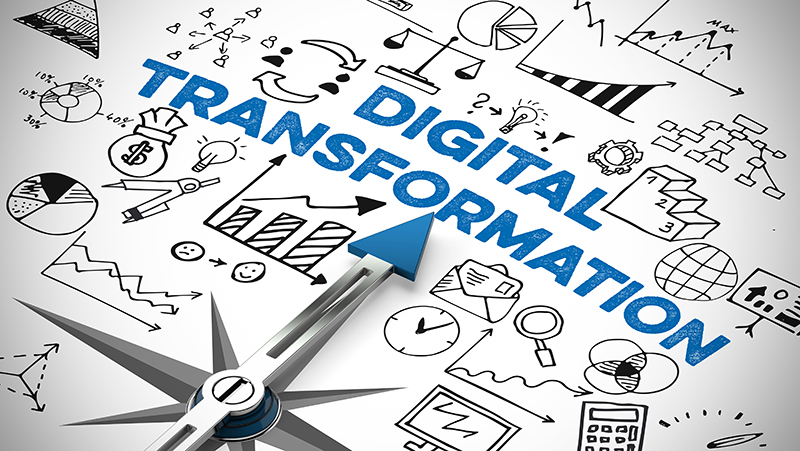In association with Huawei
How AI is powering the next wave of digital transformation
The future is AI and it’s going to bring in a whole new era for businesses

Over the course of the next few years, artificial intelligence (AI) will quickly become one of the most powerful forces driving the next wave of digital transformation.
While the idea of digital transformation is nothing new for businesses of all sizes, with the likes of automation, cloud computing, and data analytics providing significant boosts in productivity and efficiency, the new age of AI-powered tools has only boosted the reach and impact of such technologies.
But when it comes to the next phase of digital transformation, AI is set to take the driving seat, reshaping entire industries and sectors across the world and ushering in a new era for businesses everywhere.
There will be of course, the need for other considerations to ensure organizations in myriad sectors can set themselves up for AI success, according to the first EY AI Pulse Survey, published in July 2024.
“The world in which we do business has been forever altered by the emergence of generative AI,” said Dan Diasio, EY global AI consulting leader.
“Nearly all companies are investing in AI, but we’re seeing a divergence between companies experimenting in small ways and those making larger investments, with the leaders who continue prioritizing investments in AI increasingly ahead of the pack and experiencing positive returns.”
The AI shift
Historically, digital transformation was associated with a desire to boost and evolve existing business processes and infrastructure utilizing the latest technologies.
Sign up today and you will receive a free copy of our Future Focus 2025 report - the leading guidance on AI, cybersecurity and other IT challenges as per 700+ senior executives
Initially, this took the form of initiatives such as shifting from physical to digital workflows, or adopting cloud-based solutions to boost collaboration and productivity. While this first wave undoubtedly enhanced a huge number of business processes operations, the full potential of digital technologies was still somewhat constrained by the limitations of human involvement, with manual decision-making, rigid processes such as mandatory approvals, and staff-led data interpretation all hindering development.
AI will undoubtedly help to change this, giving companies the chance to move from merely digitizing processes to fully optimizing them in their own vision, adding intelligent decision-making capabilities to existing digital systems to creating autonomous workflows that can evolve and improve over time without the need for any human intervention.
Innovation is data-driven
One of the primary drivers of digital transformation has always been the ability to get the most out of your data in order to make better business decisions. Companies are generating and collecting more data every day than ever before, but in order to process, analyze and extract the best insights from this in real-time, you need AI-powered tools and platforms.
Traditional data analytics approaches are often simply unable to cope with the scale, complexity, and frequency of modern data streams seen at larger businesses or organizations - but AI tools such as predictive analytics, pattern recognition, and natural language processing (NLP) can unlock useful insights faster and more accurately than ever before.
For instance, a business intelligence firm could use AI to analyze vast amounts of transactional, operational, and customer data to detect patterns, forecast trends, and offer recommendations. AI is being used to develop hyper-personalized customer experiences in retail and finance industries, where each user interaction is informed by real-time data analysis, with a focus on individualized customer journeys resulting in better engagement and performance, hopefully leading to greater loyalty.
In healthcare, AI-powered diagnostic tools are not only automating analysis of medical images, but are also learning from vast datasets to detect anomalies that human practitioners might miss due to overwork or simple human error. The combination of AI and big data is providing doctors with augmented intelligence that assists in diagnosing diseases earlier and more accurately, saving lives with their speed.
The next level of automation
The automation of everyday or routine tasks has been another welcome digital transformation boost, but AI can take this even further with so-called “hyper-automation”.
While automation involves predefined rules to execute repetitive tasks, hyper-automation, powered by AI, combines machine learning, NLP, and robotic process automation (RPA) to create systems that can adapt to new situations, learn from previous activities, and even make decisions autonomously.
This means AI-driven robotics are increasingly becoming integral to manufacturing production lines, adjusting their actions based on inputs, and making real-time improvements to the assembly process, improving not just efficiency by reducing waste, but boosting quality control as well.
Similarly, in financial services, AI is streamlining key operations like compliance, risk assessment, and fraud detection, with hyper-automation allowing firms to automate entire workflows rather than just discrete tasks. The system adapts to changes in regulations, learns from historical fraud patterns, and continuously improves its risk assessment models without requiring human intervention at every stage, cutting costs and boosting efficiency.
Importantly, this use of AI will be complementary to existing resources. Indeed, Gartner predicts that the majority (90%) of finance functions will have implemented at least one AI-enabling solution. But during the same period, less than 10% will reduce headcount, according to the analyst firm.
“Despite AI’s ability to emulate human performance, algorithms cannot match the unique capabilities of people in areas that require creativity and complex problem solving,” said Ash Mehta, senior director analyst in the Gartner Finance practice.
“By recognizing the respective strengths of people and machines, finance leaders can build processes that boost the abilities of people and machines, while mitigating their weaknesses. This requires a new kind of collaboration between people and machines that will improve business performance and employee satisfaction.”
Boosting human decision-making
One of the most profound effects of AI on digital transformation is its ability to augment human decision-making. Rather than replacing human workers, AI can empower them by analyzing huge datasets to offer insights impossible for an individual or team to uncover manually.
For example, retail firms could use AI systems to predict inventory needs, suggest product optimizations, and personalize marketing efforts - all while leaving the final decisions in human hands. It may be an AI tool that flags a rising trend based on customer social media data, but ultimately it will be down to
In the financial sector, AI enhances investment decisions by tracking market patterns, analyzing economic indicators, and monitoring real-time social sentiment, allowing analysts to make more informed decisions, reduce risks, and capitalize on opportunities that traditional tools might miss.
As AI transforms back-end processes, it also plays a crucial role in the front-end customer experience. Chatbots and virtual assistants, powered by AI, have become the face of customer interaction in many industries, with the ability to handle basic queries, assist with troubleshooting, and provide personalized recommendations, all while learning from each interaction to improve future responses - and crucially, with the ability to hand off to a human if a greater level of interaction is required.
Augmented and virtual reality (AR/VR) applications are also being used by retailers to allow customers to try on clothes or visualize furniture in their homes before making a purchase, combining AI's ability to process preferences with immersive experiences that engage customers in new ways.
Recommendation systems are a common sight from platforms such as Amazon and Netflix, which use AI algorithms to suggest products or content tailored to individual preferences, analyzing viewing or purchasing history, alongside millions of other users, to provide the most relevant options, improving user engagement and satisfaction.
Where to next?
AI seems set to take a central role in the next wave of digital transformation, allowing businesses to completely re-evaluate how they operate, innovate, and interact with customers.
From streamlining operations through hyper-automation to revolutionizing customer experience and decision-making, AI offers transformative capabilities that are pushing industries forward.
However, as with any powerful tool, it comes with challenges, with ethical concerns, data governance, and the need for human oversight all needing to be considered.
But as companies continue to harness the potential of AI, they need to ensure their transformation is not only about deploying the latest technologies, but about creating long-lasting systems that continuously learn, adapt, and drive value - ultimately paving the way for a more data-driven, efficient, and successful future.
-
 Complacent Gen Z and Millennial workers are more likely to be duped by social engineering attacks
Complacent Gen Z and Millennial workers are more likely to be duped by social engineering attacksNews Overconfidence and a lack of security training are putting organizations at risk
-
 Tapping into the ’touch grass’ movement in cybersecurity
Tapping into the ’touch grass’ movement in cybersecurityIndustry Insights With cybersecurity experiencing a ’touch grass’ moment, what role should resellers play?
-
 Striding towards the intelligent world
Striding towards the intelligent worldSponsored Content As global industries rapidly shift gears from digitalization to digital-intelligent transformation, data storage emerges as the critical driver of this evolution
-
 Driving efficiency in distribution and logistics through the power of AI
Driving efficiency in distribution and logistics through the power of AISupported Content AI is transforming industries around the world - and logistics is ripe for change.
-
 How is AI being used in education?
How is AI being used in education?Supported Content AI has the potential to enhance the learning experience and save valuable time that can be put back into the hands of educators to use where it matters most…
-
 How AI is accelerating digital transformation in the banking industry
How AI is accelerating digital transformation in the banking industrySupported Content Gen AI, fraud detection, and chatbots are all transforming the financial industry, but the cloud is the foundation for it all